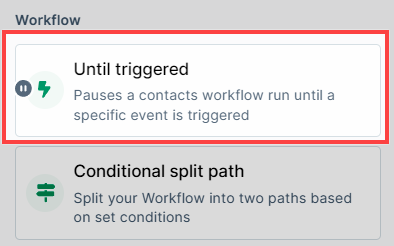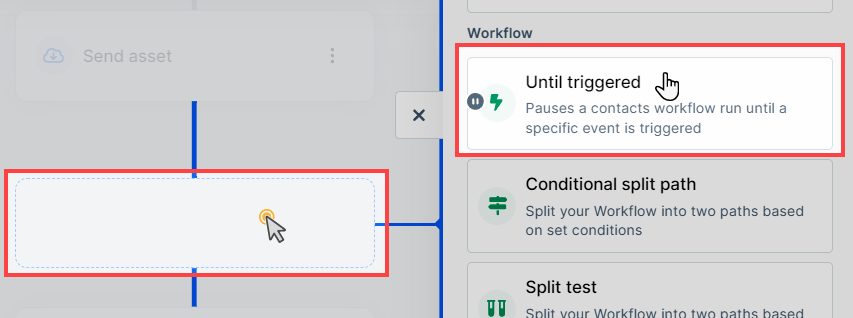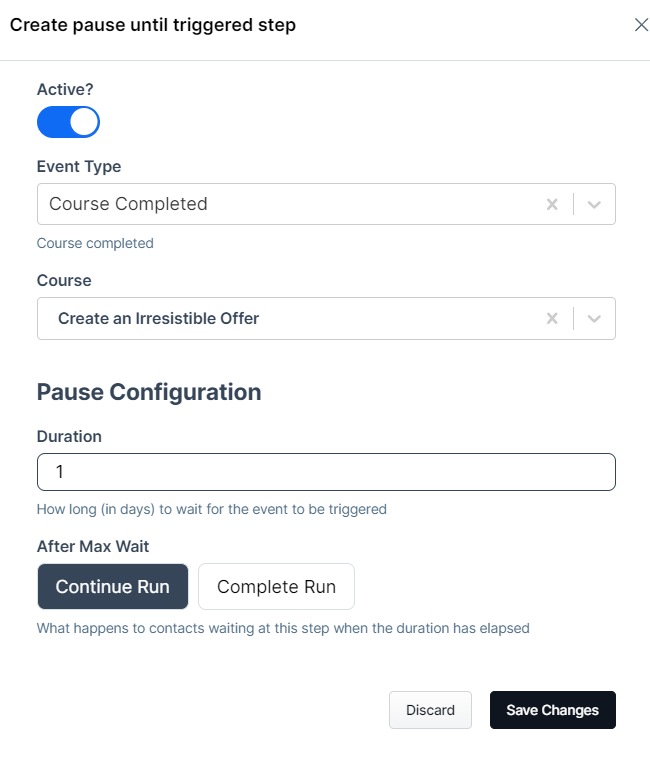The “Until Triggered” step in ClickFunnels workflows is a powerful tool that allows you to pause the execution of a workflow until a specific event occurs. This step is particularly useful when you need to wait for a particular action or condition to be met before continuing with the workflow. Whether you’re waiting for a tag to be applied, a purchase to be made, or any other event, the “Until Triggered” step gives you the flexibility to control the timing and flow of your automated processes. In this article, we’ll explore how to configure and use the “Until Triggered” step to enhance your workflows.

Requirements
An active ClickFunnels account
Adding the “Until Triggered” Step to Your Workflow
Open Your Workflow:
From your ClickFunnels dashboard, navigate to the Automations » Workflows menu.
Open an existing workflow or create a new one.
Add the “Until Triggered” Step:
Click on the Plus Icon (+) in your workflow editor.
In the right-hand panel, select the “Until Triggered” option under the “Workflow” category.

Configuring the “Until Triggered” Step
Once you’ve added the “Until Triggered” step to your workflow, you can configure it to suit your specific needs:

Active: This toggle switch allows you to activate or deactivate the “Until Triggered” step. When deactivated, the workflow will skip this step and continue without waiting for the event to occur.
Event Type: Event Type defines the specific event that will trigger the workflow to continue. Examples include actions like “
Applied Tag,” “Page View,” “Appointment Scheduled,” or “MessageHub - Agent Conversation Started.” Depending on the event type you select, additional options will appear to further specify the event type location.Event Type Location: Based on the selected event type, you’ll need to configure specific settings. For instance, If you select “
MessageHub - Agent Conversation Started,” you’ll need to choose the specific inbox where the conversation should start. Similarly, If you select “Appointments - Appointment Scheduled,” you will choose the specific calendar and appointment type.Pause Configuration:
Duration: Define how long (in days) the workflow should wait for the specified event to occur. If the event does not occur within this time frame, the workflow will proceed based on the “After Max Wait” configuration.
IMPORTANT
Key Considerations for Setting the Pause Duration:
The minimum duration you can set is 1 day, and it must be an integer value (e.g., 1, 2, 3, etc.).
The workflow will proceed to the next step as soon as the specified event occurs, regardless of the remaining duration. The duration only determines how long the system should wait for the event to occur. If the event does not occur within the specified duration, the workflow will move forward based on the selected option (Continue Run or Complete Run).
If you need the workflow to wait indefinitely until the condition is met, consider setting a large duration, such as 1500 days, to ensure the contact has ample time to meet the criteria.
After Max Wait: This setting determines what happens if the event has not been triggered within the specified duration. Continue Run and Complete Run apply only when the max duration time is met.
Continue Run: The workflow will continue running, moving on to the next step, even if the event hasn’t occurred.
Complete Run: The workflow will terminate immediately, even if there are subsequent steps following the “Until Triggered” step.
Practical Use Cases
The “Until Triggered” step can be used in a variety of scenarios to enhance your automation strategies:
Waiting for User Action: For example, you might want to wait until a contact completes a specific action, such as signing up for a course, before sending course materials.
Conditional Progression: This step can be used to ensure that certain conditions are met before the workflow continues, such as confirming that a contact has received a particular tag.
Time-Sensitive Triggers: You can configure the step to wait for a specified duration before deciding whether to continue or complete the workflow based on whether the event has occurred.
Difference Between “Until Triggered” Step and “Conditional Goal” Step
Understanding the distinction between the “Until Triggered” step and the “Conditional Goal” step is crucial for effectively managing your ClickFunnels workflows. While both steps are designed to manage workflow progression based on specific conditions, they serve different purposes and behave differently within the workflow.

“Until Triggered” Step
The “Until Triggered” step is used to temporarily pause the workflow at a specific point, waiting for a predefined event or condition to occur before allowing the workflow to continue. This step ensures that the contact does not proceed to the next step until the specified condition is fulfilled or the maximum wait time has passed. The “Until Triggered” step is particularly useful when you want to ensure that a contact completes all preceding steps before moving forward.
Example Use Case: The “Until Triggered” step is ideal for scenarios where you need to deliver specific content or grant access based on a user’s actions. For instance, in an educational workflow, you might want to wait until a student completes a particular module or lesson before granting access to the next module. After the student finishes the initial lessons, the workflow pauses at the “Until Triggered” step until the completion is detected, at which point the workflow continues and grants access to the subsequent content.
“Conditional Goal” Step
The “Conditional Goal” step, on the other hand, acts as a dynamic checkpoint within your workflow. Unlike the “Until Triggered” step, the “Conditional Goal” step does not pause the workflow. Instead, it continuously monitors the contact’s actions to determine if the defined conditions have been met.
If a contact meets the goal criteria at any point in the workflow, they are immediately pulled forward to the “Conditional Goal” step, skipping any preceding steps that have not yet been completed. This feature is particularly useful for streamlining workflows and avoiding unnecessary steps once the goal has been achieved. However, if a contact completes all steps leading up to the “Conditional Goal” step without meeting the goal conditions, they will still move forward to the next steps in the workflow, even if the goal criteria were not fulfilled.
Example Use Case: The “Conditional Goal” step is especially effective in scenarios like abandoned cart recovery. For instance, if a contact starts a purchase but doesn’t complete it, you might set up a workflow with reminder emails. If the contact completes the purchase after the first reminder, the “Conditional Goal” step will recognize this and pull the contact forward, skipping the remaining reminder emails and moving directly to the next relevant step or end the abandoned cart sequence.